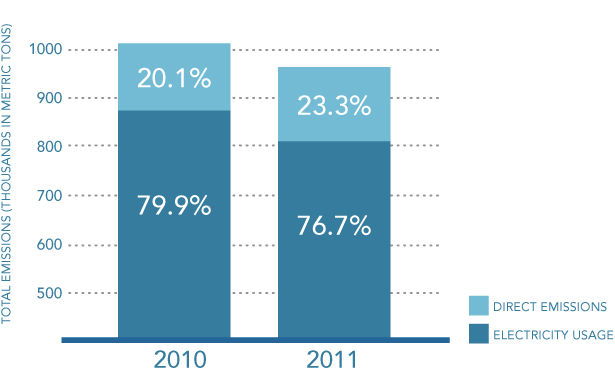Tackling Climate Change
In addition to increased erosion and infestation by pests, coffee farmers are reporting shifts in rainfall and harvest patterns that are hurting their communities and shrinking the available usable land in coffee regions around the world.
Addressing climate change is a big priority for Starbucks. We believe now is the time to increase our investments in solutions and strategies that address this crisis. The steps we're taking not only address our environmental footprint – they help to ensure the supply of high-quality coffee that our customers expect from us into the future.
Our Goal
We’re committed to supporting programs that facilitate farmers’ access to carbon markets, allowing them to generate additional income while helping to prevent deforestation.
What We've Been Doing
Starbucks has been implementing a climate change strategy since 2004, focusing on renewable energy, energy conservation and collaboration and advocacy. We're working to significantly shrink our environmental footprint by conserving energy and water, reducing the waste associated with our cups, increasing recycling and incorporating green design into our stores. We're also committed to championing progressive climate change policy in partnership with other businesses and organisations.
Starbucks & CI’s Coffee Carbon Projects
We are concerned about the potential impacts of climate change on coffee-growing regions. To help address this issue, we’ve partnered with Conservation International to conduct pilots to improve coffee production, conserve and restore natural habitat, and explore opportunities to facilitate farmer access to forest carbon markets.
Last year we engaged 29 coffee-growing communities in Sumatra, Indonesia, and Chiapas, Mexico – regions with distinctly sensitive environments and differing coffee-growing traditions – in the pilot programs. We’re now working to engage at least 20 additional communities in these areas.
Through our expanded relationship with Conservation International, we’re piloting forest conservation incentive programs that link coffee farmers to carbon markets. Under this model, we’re working with farmers to carry out actions that reduce carbon emissions.
Greenhouse Gas Emissions
To continue to track and quantify our own environmental footprint, we conducted an inventory of our greenhouse gas (GHG) emissions in 2011. Using the World Resources Institute/WBCSD Greenhouse Gas Protocol, we evaluated the major emissions from our global retail stores and roasting operations. Because more than 80 percent of our GHG emissions are attributable to energy for use in our stores, offices, and roasting plants, we are focusing our efforts on energy conservation and the purchase of renewable energy.

Starbucks used the WRI/WBCSD GHG Protocol Corporate Standard to assess our fiscal 2010 greenhouse gas emissions. The 2011 inventory found our Scope 1 and Scope 2 emissions were 979,963 metric tons of carbon dioxide. According to the Protocol, Scope 1 includes direct GHG emissions from sources that are owned or controlled by the company. For Starbucks these include coffee roasting plants, store operations, and company-owned vehicles and aircraft. Scope 2 includes indirect GHG emissions from the generation of purchased electricity consumed by the company. The great news is that, compared to our 2010 GHG footprint of 1,006,954 mtons*, we succeeded in reducing our GHG emissions by 2.7% on an absolute basis. This reflects the success of our energy efficiency program.
*2010 footprint adjusted due to corrected information from vendors







